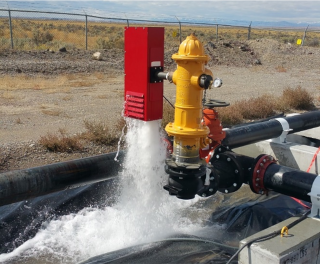Drinking Water Infrastructure Resilience and Sustainability Research
EPA is developing resources and tools toward a systems approach for maintaining drinking water infrastructure performance and integrity and increasing infrastructure resilience. This includes developing approaches to protect human health, minimizing the current and long-term costs of supplying water to all customers, and assessing vulnerability to, preparedness for, and response and recovery from extreme weather and other disasters. Research techniques utilize modeling, data analytics, and management tools, as well as analytical, geospatial, and commercially available sensor data to assess system conditions, hydraulics, water quality, and resilience from source water to the consumer’s tap.
- Drinking Water Distribution Systems
- Water Security and Emergency Response
- Additional Resilience and Sustainability Resources
Drinking Water Distributions Systems

Drinking water distribution systems are large, complex, and unique ecosystems. Proper management is critical to delivering safe water and maintaining the public health of a community. In storage tanks and on pipe walls, contaminants can accumulate, biofilm can multiply, iron materials can corrode, and other infrastructure components can weaken, deteriorate, and form leaks. Contaminants can also propagate and accumulate in premise plumbing systems within homes and buildings. All of these make it harder to maintain disinfectant residuals and water quality from the treatment plant to the tap.
Maintaining Water Quality and Building Distribution System Reliability
EPA research is addressing multiple approaches to maintaining water quality and building the resilience and reliability of distribution systems, including monitoring, modeling, booster disinfection, optimization of tank operations, and replacing/repairing infrastructure. Much of the focus is on developing and evaluating approaches that are affordable and practical for small and/or vulnerable communities.
Distribution System Corrosion Control

Distribution system corrosion occurs when the pipes that carry treated drinking water are gradually worn away by a chemical reaction between water and the metal surface (pipe wall or solder). A number of factors can be involved in the extent to which metal pipes corrode, including the chemistry of the water (acidity and alkalinity), and the types and amounts of minerals in the water, temperature of the water, the amount of wear in the pipes and how long the water stays in pipes, and the presence of protective scales or coatings inside the pipes.
This corrosion can result in metal release, such as lead and copper, into the water if pipes are not protected. It can also cause reaction with disinfectants used to treat for microbial contaminants, which can result in disinfection byproducts and increased pathogen growth. Effective corrosion control can reduce these concerns and also decreases the risk of costly infrastructure repairs or replacement.
EPA researchers are expanding scientific understanding of corrosion concerns and developing resources and tools to assist water systems.
Corrosion and Lead and Copper
Corrosion and solubility play major roles in controlling the release of lead and copper from lead service lines and other plumbing materials into drinking water. Key water quality parameters, such as pH, alkalinity, dissolved organic carbon, disinfectants, and corrosion inhibitors, interact with lead and copper materials in complex ways that can result in corrosion and release into drinking water sources.

Lead that is released into drinking water supplies can pose serious risks to public health, especially to children. The release of copper from distribution materials can lead to excessive localized or pitting corrosion, which is typically not associated with elevated copper levels or regulatory considerations but can be a major financial burden as well as an inconvenience to homeowners.
Corrosion and Pathogens
Corroding metals and associated corrosion products in finished water can react with disinfectants, causing areas of low disinfectant residual in the distribution system. Low disinfectant residual can increase the potential for microbial growth, including the growth of opportunistic pathogens. Effective corrosion control treatment and distribution system maintenance can allow for better control of microbial growth.
EPA researchers are expanding scientific understanding of corrosion concerns and developing resources and tools for characterizing and mitigating lead and copper in drinking water distribution systems and premise plumbing.
Research Efforts
- Exploring the relative value of lead and copper corrosion control assessment approaches, such as pipe rigs and coupon studies for predicting the impact of water treatment changes and alternative corrosion control treatment approaches on full-scale treatment decisions.
- Developing and evaluating strategies to reduce metal corrosion byproducts in water. This effort will consider uniform corrosion, galvanic corrosion, lead and copper solubility, and the role of biofilm on metal release. The impact of water quality, including disinfectants, corrosion inhibitors, source water, and water treatment changes is also being explored.
- Examining the role of particles in metal release from distribution system materials. This effort includes a comprehensive investigation of lead particulate occurrence and significance across various water qualities and corrosion control strategies. The research will combine bench- and pilot-scale investigations and build on case studies and field investigations/demonstrations.
- Development of corrosion control strategies for minimizing pitting and release of contaminants in water-delivery systems.
- Characterization of lead and copper in distribution systems and premise plumbing to assess lead release mechanisms and corrosion control effectiveness.
- Examining the relationships between health risks associated with disinfection byproducts (DBPS), disinfectant residuals, pathogen occurrences and corrosion control of public distribution systems and premise plumbing.
Water Security and Emergency Response
Disasters, whether human-made or naturally occurring, can impact the ability of drinking water utilities to function, including the potential disruption of drinking water supplies to municipalities. Water systems, including water treatment and distribution systems, are a critical infrastructure system and require increased protection and the ability for utilities to detect, respond to, and recover from physical and cyber threats and attacks. Water system managers need to know when their treatment systems, pumps, valves, tanks, etc. are being compromised, how to stop an attack, and how to recover so that safe and full service can be returned to the community.
EPA researchers are conducting studies and developing modeling tools and technologies that aid the design and operation of drinking water systems in a way that decreases their vulnerability to disasters. This research is contributing to a resilient water sector, with tools and methodologies to respond to drinking water and source water contamination incidents and minimize the time that these systems are offline.
Cyber and Physical Protection and Resilience
Water systems, including water treatment and distribution systems, are considered one of the nation’s critical infrastructures. Critical infrastructure requires increased protection and the ability for utilities to detect, respond to, and recover from physical and cyber threats and attacks. Water system managers need to know when their treatment systems, pumps, valves, tanks, etc. are being compromised, how to stop an attack, and how to recover so that safe and full service can be returned to the community.
Resilient water infrastructure systems can facilitate quick and effective decision making during emergency situations, including cyberattacks, to ensure access to adequate water capacity and quality. In partnership with the Department of Homeland Security, water utilities, and private sector, EPA researchers will be demonstrating and documenting the impact of cybersecurity vulnerabilities on internet-facing operating technology process control systems. This work can inform and evaluate utility response or mitigation actions that could counter or prevent the impacts of a cyberattack. Ultimately, the impact of this work will be a water sector with the tools and methodologies needed to prevent or mitigate high impact cyberattacks on both physical and Supervisory Control and Data Acquisition (SCADA) infrastructure.
EPA also led a steering committee of water industry experts to develop the capability to evaluate and test cybersecurity equipment for the protection of water system infrastructure. Research to improve the cyber security of water utilities is carried out at the EPA Water Security Test Bed (WSTB) located at the Department of Energy Idaho National Laboratory.
Contaminant Detection
EPA research furthers the understanding of contaminants’ movement and persistence in drinking water systems to inform decision making regarding detection, decontamination, waste management, and operational countermeasures. Most drinking water utilities use commercially available water quality sensors to monitor for changes in water quality indicators. These indicators may include pH, levels of free or total chlorine, and total organic carbon.
EPA has tested commonly used sensors to learn if they can detect water contaminated with these chemical, biological, or radiological agents, in addition to detecting routine water quality variations. Research focuses on novel detection technologies that are new to the market, and technologies that could detect contamination in source water, such as reservoirs.
Infrastructure Decontamination
Intentional or unintentional contamination of a drinking water distribution system can affect human health and result in high costs to return the water system to service. Many contaminants, whether they are chemical, biological, or radiological, can adhere to or become embedded in rusty or corroded pipes or in biologically active layers (biofilm) on the pipe walls. EPA researchers examine techniques to clean, or decontaminate, contaminated water infrastructure including, pipes, valves and tanks.
Treatment During an Emergency Response
Following an emergency event, communities need access to clean water not only for drinking but also for cooking, cleaning, and medical triage. EPA is researching decision support tools to help decision makers balance the many factors that go into the design and implementation of a treatment system at their site.
Learn more about drinking water treatment during an emergency response.

